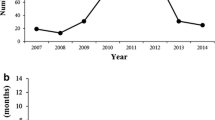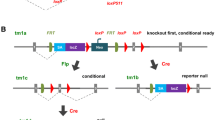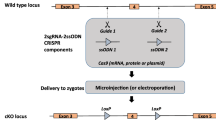Abstract
Mice with targeted genetic alterations are the most effective tools for deciphering organismal gene function. We generated an ENU-based parallel C3HeB/FeJ sperm and DNA archive characterized by a high probability to identify allelic variants of target genes as well as high efficiencies in allele retrieval and model revitalization. Our archive size of over 17,000 samples contains approximately 340,000 independent alleles (20 functional mutations per individual sample). Based on an estimated number of approximately 30,000 mouse genes, the parallel sperm/DNA archive should permit the identification and recovery of ten or more alleles per average target gene which translates to a calculated 99% success rate in the discovery of five allelic variants for any given average gene. The low rate of unrelated ENU-induced passenger mutations has no practical impact on the analysis of the allele-specific phenotype at the G3 generation because of dilution and free segregation of such unrelated passenger mutations. To date 39 mouse models representing 33 different genes have been recovered from our archive using in vitro fertilization techniques. The generation time for a murine model heterozygous for a mutation in a gene of interest is less than 2 months, i.e., three to four times faster compared with current embryonic stem-cell–based technologies. We conclude that ENU-based targeted mutagenesis is a powerful tool for the fast and high-throughput production of murine gene-specific models for biomedical research.
Similar content being viewed by others
References
Auerbach W, Dunmore JH, Fairchild-Huntress V, Fang O, Auerbach AB, et al. (2000) Establishment and chimera analysis of 129/SvEv- and C57BL/6-derived mouse embryonic stem cell lines. Biotechniques 29(5): 1024–1032
Beier DR, (2000) Sequence-based analysis of mutagenized mice. Mamm Genome 11(7): 594–597
Coghill EL, Hugjll A, Parkinson N, Davidson C, Glenister P, et al. (2002) A gene-driven approach to the identification of ENU mutants in the mouse. Nat Genet 30(3): 255–256
Favor J (1994) Specific-locus mutation test in germ cells of the mouse: an assessment of the screening procedures and the mutational events detected. In Male-Mediated Developmental Toxicity Mattison DR, Olshan AF, eds. (New York: Plenum Press), pp 23–36
Fitch KR, McGowan KA, van Raamsdonk CD, Fuchs H, Lee D, et al. (2003) Genetics of dark skin in mice. Genes Dev 17(2): 214–228
Girald–Rosa W, Vleugels RA, Musiek AC, Sligh JE (2005) High-throughput mitochondrial genome screening method for nonmelanoma skin cancer using multiplexed temperature gradient capillary electrophoresis. Clin Chem 51: 305–311
Hafezparast M, Klocke R, Ruhrberg C, Marquardt A, Ahmad–Annuar A, et al. (2003) Mutations in dynein link motor neuron degeneration to defects in retrograde transport. Science 300(5620): 808–812
Hansen J, Floss T, Van Sloun P, Fuchtbauer EM, Vauti F, et al. (2003) A large-scale, gene-driven mutagenesis approach for the functional analysis of the mouse genome. Proc Natl Acad Sci U S A 100(17): 9918–9922
Harada A, Takei Y, Kanai Y, Tanaka Y, Nonaka S, et al. (1998) Golgi vesiculation and lysosome dispersion in cells lacking cytoplasmic dynein. J Cell Biol 141(1): 51–59
Hitotsumachi S, Carpenter DA, Russell WL (1985) Dose-repetition increases the mutagenic effectiveness of N-ethyl-N-nitrosourea in mouse spermatogonia. Proc Natl Acad Sci U S A 82(19): 6619–6621
Hrabe de Angelis MH, Flaswinkel H, Fuchs H, Rathkolb B, Soewarto D, et al. (2000) Genome-wide, large-scale production of mutant mice by ENU mutagenesis. Nat Genet 25(4): 444–447
Justice MJ, Carpenter DA, Favor J, Neuhauser-Klaus A, Hrabe de Angelis M, et al. (2000) Effects of ENU dosage on mouse strains. Mamm Genome 11(7): 484–488
Ledermann B (2000) Embryonic stem cells and gene targeting. Exp Physiol 85(6): 603–613
Ledermann B, Burki K (1991) Establishment of a germ-line competent C57BL/6 embryonic stem cell line. Exp Cell Res 197(2): 254–258
Li Q, Liu Z, Monroe H, Culiat CT (2002) Integrated platform for detection of DNA sequence variants using capillary array electrophoresis. Electrophoresis 23(10): 1499–1511
Marschall S, Hrabe de Angelis M (2003) In vitro fertilization/cryopreservation. Methods Mol Biol 209: 35–50
Marschall S, Huffstadt U, Balling R, Hrabe de Angelis M (1999) Reliable recovery of inbred mouse lines using cryopreserved spermatozoa. Mamm Genome 10(8): 773–776
Murphy K, Hafez M, Philips J, Yarnell K, Gutshall K, et al. (2003) Evaluation of temperature gradient capillary electrophoresis for detection of the factor v leiden mutation: coincident identification of a novel polymorphism in factor v. Mol Diagn 7(1): 35–40
Nadeau JH, Balling R, Barsh G, Beier D, Brown SD, et al. (2001) Sequence interpretation. Functional annotation of mouse genome sequences. Science 291(5507): 1251–1255
Nolan PM, Peters J, Strivens M, Rogers D, Hagan J, et al. (2000) A systematic, genome-wide, phenotype-driven mutagenesis programme for gene function studies in the mouse. Nat Genet 25(4): 440–443
Noveroske JK, Weber JS, Justice MJ (2000) The mutagenic action of N-ethyl-N-nitrosourea in the mouse. Mamm Genome 11(7): 478–483
Patrucco E, Notte A, Barberis L, Selvetella G, Maffei A, et al. (2004) PI3Kgamma modulates the cardiac response to chronic pressure overload by distinct kinase-dependent and -independent effects. Cell 118(3): 375–387
Quwailid MM, Hugil A, Dear N, Vizor L, Wells S, et al. (2004) A gene-driven ENU-based approach to generating an allelic series in any gene. Mamm Genome 15(8): 585–591
Russ A, Stumm G, Augustin M, Sedlmeir R, Wattler S, et al. (2002) Random mutagenesis in the mouse as a tool in drug discovery. Drug Discov Today 7(23): 1175–1183
Russell WL, Kelly EM, Hunsicker PR, Bangham JW, Maddux SC, et al. (1979) Specific-locus test shows ethylnitrosourea to be the most potent mutagen in the mouse. Proc Natl Acad Sci U S A 76(11): 5818–5819
Russell WL, Hunsicker PR, et al. (1982) Effect of dose fractionation on the ethylnitrosourea induction of specific-locus mutations in mouse spermatogonia. Proc Natl Acad Sci U S A 79(11): 3592–3593
Schoonjans L, Kreemers V, Danloy S, Moreadith RW, Laroche Y, et al. (2003) Improved generation of germline-competent embryonic stem cell lines from inbred mouse strains. Stem Cells 21(1): 90–97
Silver L (1995)The mouse genome. In Mouse Genetics: Concepts and Applications, Silver L, ed. (City: Oxford University Press) pp 76-133
Skarnes WC, von Melchner H, Wurst W, Hicks G, Nord AS, et al. (2004) A public gene trap resource for mouse functional genomics. Nat Genet 36(6): 543–544
Threadgill DW, Dlugosz AA, Hansen LA, Tennenbaum T, Lichti U, et al. (1995)/Targeted disruption of mouse EGF receptor: effect of genetic background on mutant phenotype. Science 269(5221): 230–234
Threadgill DW, Yee D, Matin A, Nadeau JH, Magnusom T (1997) Genealogy of the 129 inbred strains: 129/SvJ is a contaminated inbred strain. Mamm Genome 8(6): 390–393
Till BJ, Colbert T, Tompa R, Enns LC, Codomo CA, et al. (2003) High-throughput TILLING forunctional genomics. Methods Mol Biol 236: 205–220
Vanhaesebroeck B, Rohn JL, Waterfield MD (2004) Gene targeting: attention to detail. Cell 118(3): 274–276
Weber JS, Salinger A, Justice MJ (2000) Optimal N-ethyl-N-nitrosourea (ENU) doses for inbred mouse strains. Genesis 26(4): 230–233
Wichmann B, Hill D (1987) Building a random-number generator. BYTE 12(3), 127–128
Wiles MV, Vauti F, Otte J, Fuchtbauer EM, Ruiz P, et al. (2000) Establishment of a gene-trap sequence tag library to generate mutant mice from embryonic stem cells. Nat Genet 24(1): 13–14
Zambrowicz BP, Friedrich GA, Buxton EC, Lilleberg SC, Person C, et al. (1998) Disruption and sequence identification of 2,000 genes in mouse embryonic stem cells. Nature 392 (6676), 608–611
Author information
Authors and Affiliations
Corresponding author
Additional information
M. Augustin and R. Sedlmeier contributed equally to this work.
M. Nehls and S. Wattler are Co-senior authors.
TGCE, temperature gradient capillary electrophoresis; ENU, N-ethyl-N-nitrosurea; SNP, single nucleotide polymorphism; IVF, in vitro fertilization
Rights and permissions
About this article
Cite this article
Augustin, M., Sedlmeier, R., Peters, T. et al. Efficient and fast targeted production of murine models based on ENU mutagenesis. Mamm Genome 16, 405–413 (2005). https://doi.org/10.1007/s00335-004-3028-2
Received:
Accepted:
Issue Date:
DOI: https://doi.org/10.1007/s00335-004-3028-2




